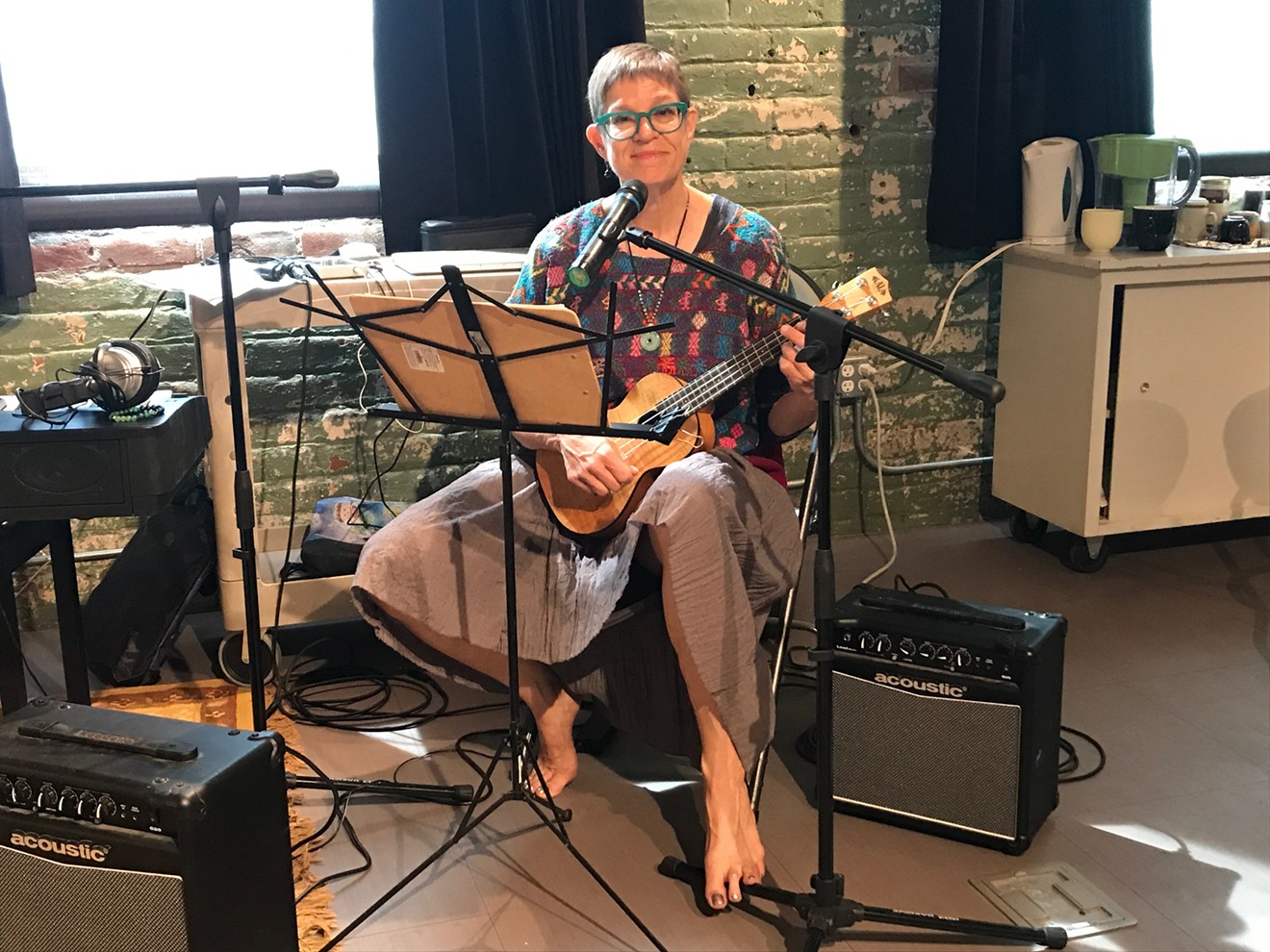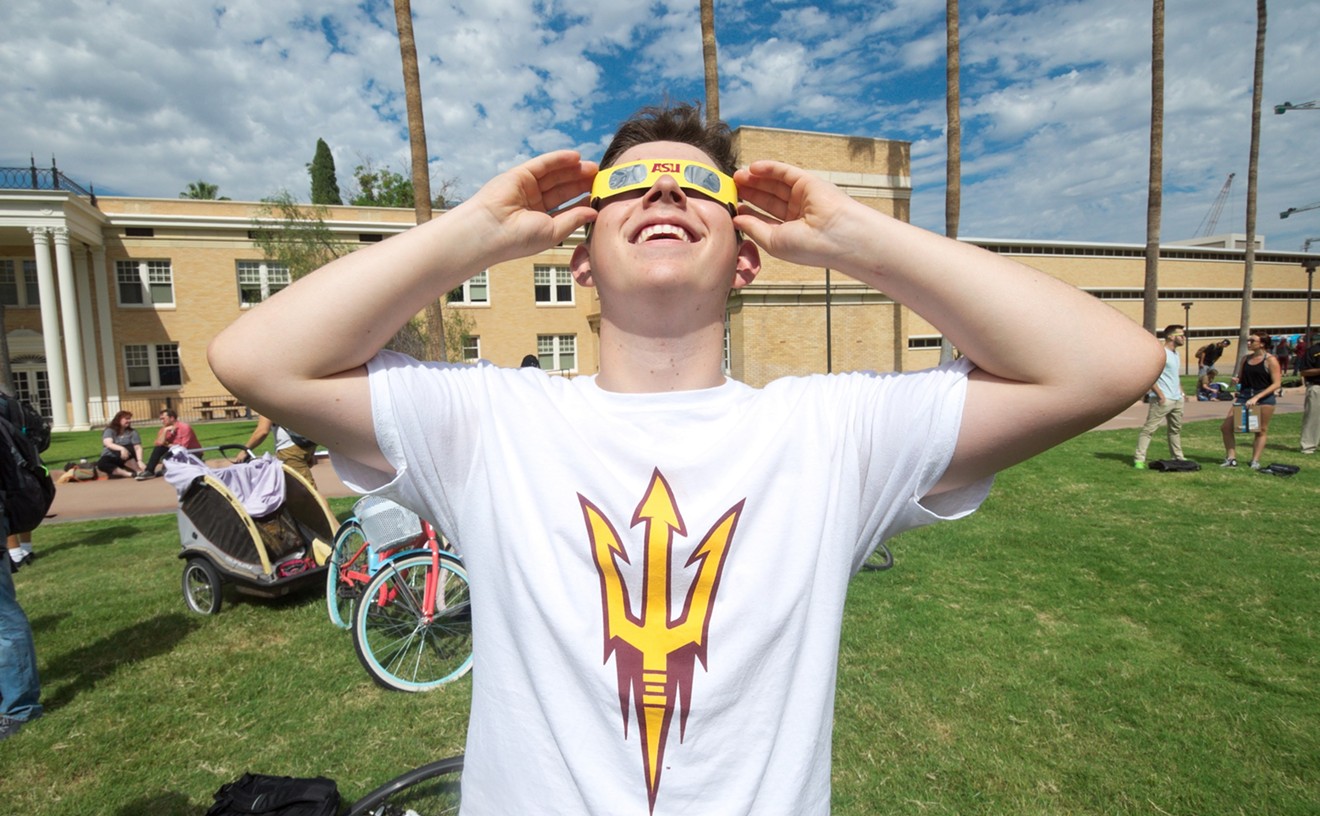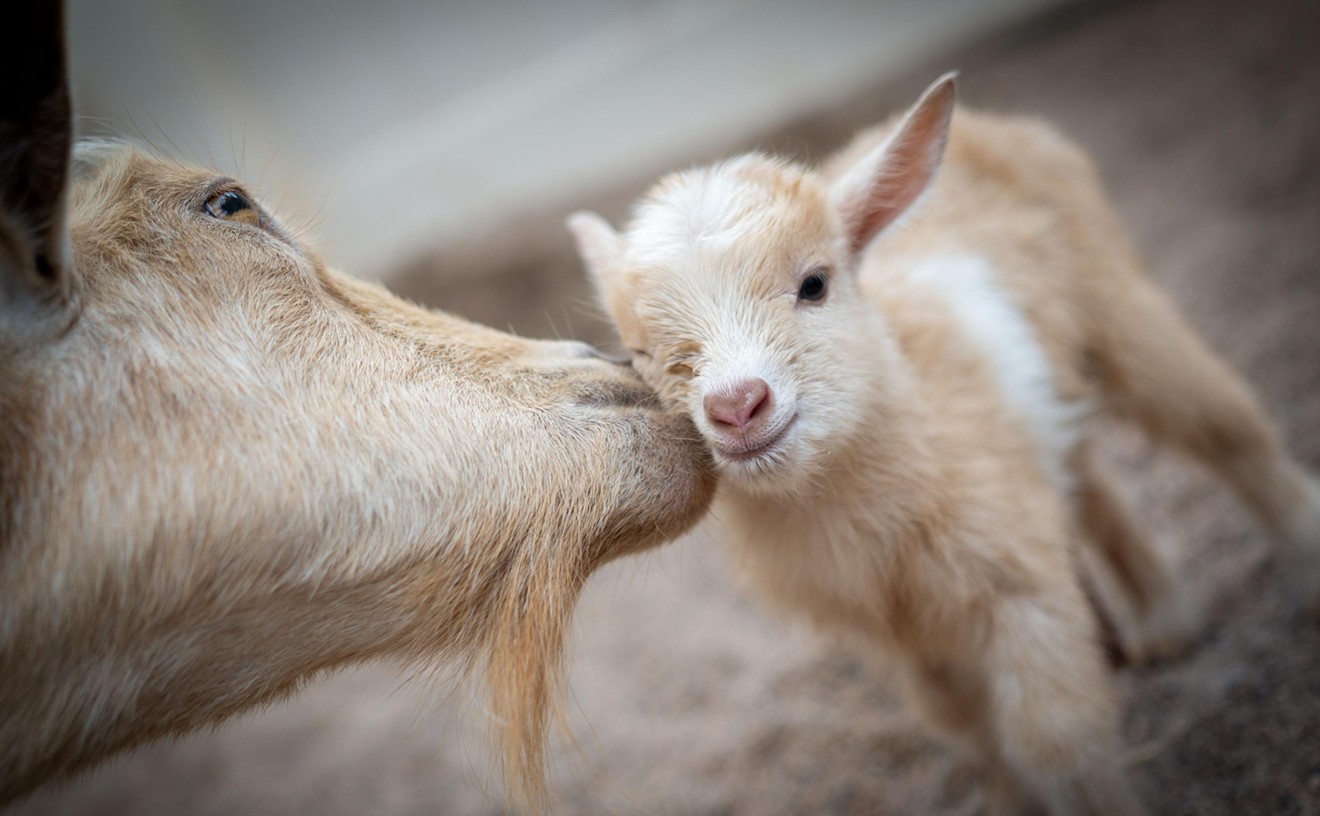In Studio Visit, we profile artists in their work spaces. This month: Adriene Jenik, whose work reflects a shared passion for art and science.
Adriene Jenik sits barefoot in front of a music stand, playing a simple song on the ukulele. It’s a Monday afternoon in March, and she's inside her space at Grant Street Studios in downtown Phoenix. The room's filled with evidence of her work's eclectic nature.
At one end of the studio is a simple desk topped with books, files, and a laptop. At the other, there’s a counter-height work surface. In between, she’s placed a rug that gives her studio a warm, homelike quality. Atop the rug, she has recording equipment, assorted percussion instruments, and a tented area for tarot card readings.
These days, the tarot cards are a central part of Jenik’s art practice. She designed her own deck, featuring images inspired by climate change. Artist Molly Koehn made the paper for the cards, and screen printed the images.
Tarot is trendy these days, but that’s not why she’s using the cards. “My mom was a professional psychic,” Jenik says. “I started gestating the work before she passed, thinking through my sadness that people aren’t listening to the science.”
Jenik uses the cards to perform climate future readings, which engage people in thinking about their own relationship to the earth. She’s done the readings in myriad settings, from academic conferences to farmers markets. “It channels science in a way people can hear it,” she says.
It’s one of many projects she’s undertaken through the years.
Several reflect her passion for the desert, first fueled by a trip to Mexico when she was 25 years old. “It was my first time in the Sonoran Desert, and I thought: This is where my bones will end up.”
She’s had an art studio in the high desert near Joshua Tree National Park since 1996.
That’s where Jenik launched an informal artist residency program called Hobe Chobe. It’s hosted hundreds of artists, and Jenik continues to spend a significant amount of time there. “I’m fortunate that ASU gives me the freedom to do that,” she says.
Jenik has a half-time contract with the university, where she’s on the School of Art faculty. She’s teaching two classes this term, in addition to doing research and further developing her own art practice.
The artist has been with ASU for nearly a decade, where she served for many years as the director for the School of Art. During her tenure, the school acquired Grant Street Studios, an adaptive reuse building in Phoenix’s warehouse district. Today it houses studios for dozens of ASU graduate students, as well as Jenik.
In 2016, Jenik decided to step down as director, so she’d have more time at the five-acre Joshua Tree compound. She sold her home in Arizona, then took it a step further.
“I sold almost all my possessions, except books, artwork, textiles, cooking things, and some clothing,” Jenik says.
She spent a year immersed in the Joshua Tree experience, where she had plenty of time to reflect on the evolution of her art practice. “I really gestated a lot and got honest with myself.” She considered the ways the world has changed in 30 years, and the ways she’s changed, as well.
For Jenik, it felt like a crossroads.
“Does the world really need me to be an artist or does the world need me to be something else right now?” It’s a question she posed to herself at Joshua Tree. “Yes, I’m supposed to be an artist,” she recalls deciding at the time.
Still, being an artist isn’t something Jenik does. It’s a way of being in the world.
“I feel like I’m a citizen of the world who really cares about things, and I’m very justice-oriented,” Jenik says. “I’m trying to do work that activates the values that I want to see in the world.”
Tell us about your work in haiku format.
How about a tanka, instead? (five lines – 31 syllables – five/seven/five/seven/seven)
Stretching and growing
My practice is to listen,
respond without fear
To become a hollow bone,
my humble aspiration
What artist(s) are you really into right now?
Taryn Simon, Andrea Zittel, Emily Johnson, the collective “not an Alternative,” Subhankar Banerjee
What are you reading?
I’m in the midst of three books.
Fiction: Sing, Unburied Sing by Jesmyn Ward.
And nonfiction: Why I’m No Longer Talking to White People About Race by Reni Eddo-Lodge; and Arts of Living on a Damaged Planet edited by Anna Tsing, Heather Swanson, Elaine Gan, and Nils Bubandt.
What's the last TV show, film, or video you watched?
Prepping for my Issues in Intermedia class, I just watched the “Mission to Earth” chapter of Lev Manovich and Andreas Kratky’s Soft Cinema project. It is an engine for producing cinema through metatagging cultural artifacts, then working with computer code to adjust variables and output.
If you could collaborate with any artists, alive or dead, who would it be? And why?
My friend, the amazing artist James Luna, passed away March 4 while at an artists’ residency in New Orleans. I wish I had had a chance to collaborate with him while he was here in physical form.
What was the last exhibition you saw and what did you think of it?
I was out at my studio in the high desert in California last week for spring break and got to see my friend Kate McCabe’s exhibition. She is painting and making collages with mushroom clouds and fancy cakes. Somehow it all made sense. I was particularly fond of a painting of a unicorn skull.
Jeff Koons or Marina Abramovic? And why?
Abramovic for sure. I’m teaching her this term, and I’m continually impressed by how her early work still affects students — and me! — so deeply. I like that she doesn’t seem to care if people think she is loopy. She is a problematic figure in many ways, but I feel how alive she is in the work and process. Her Balkan erotica film is pretty amazing…
What's the best advice you've ever received?
Learn to breathe.
What are you currently working on?
I’m prepping for a new “data humanization” performance called Blast Radius, travelling to offer climate future readings with my ECOtarot deck (Berkeley and Finland in April), presenting the drylab2023 experiment in extreme experiential learning at conferences, and writing and performing simple songs on my ukulele.
What's your most valuable tool as an artist?
An aligned mind/body/spirit.
[
{
"name": "Air - MediumRectangle - Inline Content - Mobile Display Size",
"component": "18478561",
"insertPoint": "2",
"requiredCountToDisplay": "2"
},{
"name": "Editor Picks",
"component": "16759093",
"insertPoint": "4",
"requiredCountToDisplay": "1"
},{
"name": "Inline Links",
"component": "17980324",
"insertPoint": "8th",
"startingPoint": 8,
"requiredCountToDisplay": "7",
"maxInsertions": 25
},{
"name": "Air - MediumRectangle - Combo - Inline Content",
"component": "16759092",
"insertPoint": "8th",
"startingPoint": 8,
"requiredCountToDisplay": "7",
"maxInsertions": 25
},{
"name": "Inline Links",
"component": "17980324",
"insertPoint": "8th",
"startingPoint": 12,
"requiredCountToDisplay": "11",
"maxInsertions": 24
},{
"name": "Air - Leaderboard Tower - Combo - Inline Content",
"component": "16759094",
"insertPoint": "8th",
"startingPoint": 12,
"requiredCountToDisplay": "11",
"maxInsertions": 24
}
]














